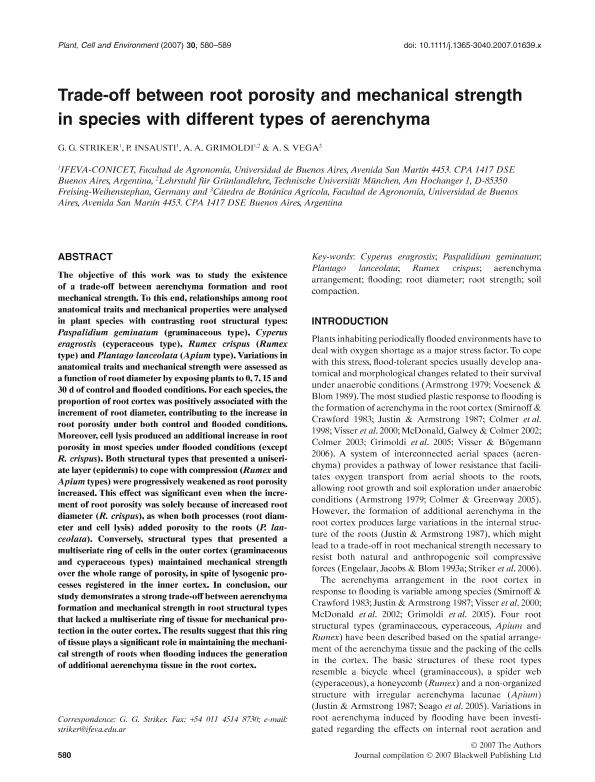Mostrar el registro sencillo del ítem
dc.contributor.author
Striker, Gustavo Gabriel

dc.contributor.author
Insausti, Pedro

dc.contributor.author
Grimoldi, Agustin Alberto

dc.contributor.author
Vega, Andrea Susana

dc.date.available
2021-05-13T19:07:15Z
dc.date.issued
2007-05
dc.identifier.citation
Striker, Gustavo Gabriel; Insausti, Pedro; Grimoldi, Agustin Alberto; Vega, Andrea Susana; Trade-off between root porosity and mechanical strength in species with different types of aerenchyma; Wiley Blackwell Publishing, Inc; Plant, Cell and Environment; 30; 5; 5-2007; 580-589
dc.identifier.issn
0140-7791
dc.identifier.uri
http://hdl.handle.net/11336/132000
dc.description.abstract
The objective of this work was to study the existence of a trade-off between aerenchyma formation and root mechanical strength. To this end, relationships among root anatomical traits and mechanical properties were analysed in plant species with contrasting root structural types: Paspalidium geminatum (graminaceous type), Cyperus eragrostis (cyperaceous type), Rumex crispus (Rumex type) and Plantago lanceolata (Apium type). Variations in anatomical traits and mechanical strength were assessed as a function of root diameter by exposing plants to 0, 7, 15 and 30 d of control and flooded conditions. For each species, the proportion of root cortex was positively associated with the increment of root diameter, contributing to the increase in root porosity under both control and flooded conditions. Moreover, cell lysis produced an additional increase in root porosity in most species under flooded conditions (except R. crispus). Both structural types that presented a uniseriate layer (epidermis) to cope with compression (Rumex and Apium types) were progressively weakened as root porosity increased. This effect was significant even when the increment of root porosity was solely because of increased root diameter (R. crispus), as when both processes (root diameter and cell lysis) added porosity to the roots (P. lanceolata). Conversely, structural types that presented a multiseriate ring of cells in the outer cortex (graminaceous and cyperaceous types) maintained mechanical strength over the whole range of porosity, in spite of lysogenic processes registered in the inner cortex. In conclusion, our study demonstrates a strong trade-off between aerenchyma formation and mechanical strength in root structural types that lacked a multiseriate ring of tissue for mechanical protection in the outer cortex. The results suggest that this ring of tissue plays a significant role in maintaining the mechanical strength of roots when flooding induces the generation of additional aerenchyma tissue in the root cortex.
dc.format
application/pdf
dc.language.iso
eng
dc.publisher
Wiley Blackwell Publishing, Inc

dc.rights
info:eu-repo/semantics/openAccess
dc.rights.uri
https://creativecommons.org/licenses/by-nc-sa/2.5/ar/
dc.subject
AERENCHYMA ARRANGEMENT
dc.subject
CYPERUS ERAGROSTIS
dc.subject
FLOODING
dc.subject
PASPALIDIUM GEMINATUM
dc.subject
PLANTAGO LANCEOLATA
dc.subject
ROOT DIAMETER
dc.subject
ROOT STRENGTH
dc.subject
RUMEX CRISPUS
dc.subject
SOIL COMPACTION
dc.subject.classification
Agricultura

dc.subject.classification
Agricultura, Silvicultura y Pesca

dc.subject.classification
CIENCIAS AGRÍCOLAS

dc.title
Trade-off between root porosity and mechanical strength in species with different types of aerenchyma
dc.type
info:eu-repo/semantics/article
dc.type
info:ar-repo/semantics/artículo
dc.type
info:eu-repo/semantics/publishedVersion
dc.date.updated
2021-04-28T21:41:24Z
dc.journal.volume
30
dc.journal.number
5
dc.journal.pagination
580-589
dc.journal.pais
Reino Unido

dc.journal.ciudad
Londres
dc.description.fil
Fil: Striker, Gustavo Gabriel. Consejo Nacional de Investigaciones Científicas y Técnicas. Oficina de Coordinación Administrativa Parque Centenario. Instituto de Investigaciones Fisiológicas y Ecológicas Vinculadas a la Agricultura. Universidad de Buenos Aires. Facultad de Agronomía. Instituto de Investigaciones Fisiológicas y Ecológicas Vinculadas a la Agricultura; Argentina
dc.description.fil
Fil: Insausti, Pedro. Consejo Nacional de Investigaciones Científicas y Técnicas. Oficina de Coordinación Administrativa Parque Centenario. Instituto de Investigaciones Fisiológicas y Ecológicas Vinculadas a la Agricultura. Universidad de Buenos Aires. Facultad de Agronomía. Instituto de Investigaciones Fisiológicas y Ecológicas Vinculadas a la Agricultura; Argentina
dc.description.fil
Fil: Grimoldi, Agustin Alberto. Universitat Technical Zu Munich; Alemania. Consejo Nacional de Investigaciones Científicas y Técnicas. Oficina de Coordinación Administrativa Parque Centenario. Instituto de Investigaciones Fisiológicas y Ecológicas Vinculadas a la Agricultura. Universidad de Buenos Aires. Facultad de Agronomía. Instituto de Investigaciones Fisiológicas y Ecológicas Vinculadas a la Agricultura; Argentina
dc.description.fil
Fil: Vega, Andrea Susana. Universidad de Buenos Aires. Facultad de Agronomía. Departamento de Recursos Naturales y Ambiente. Cátedra de Botánica Agrícola; Argentina. Consejo Nacional de Investigaciones Científicas y Técnicas; Argentina
dc.journal.title
Plant, Cell and Environment

dc.relation.alternativeid
info:eu-repo/semantics/altIdentifier/url/https://onlinelibrary.wiley.com/doi/full/10.1111/j.1365-3040.2007.01639.x
dc.relation.alternativeid
info:eu-repo/semantics/altIdentifier/doi/https://doi.org/10.1111/j.1365-3040.2007.01639.x
Archivos asociados
